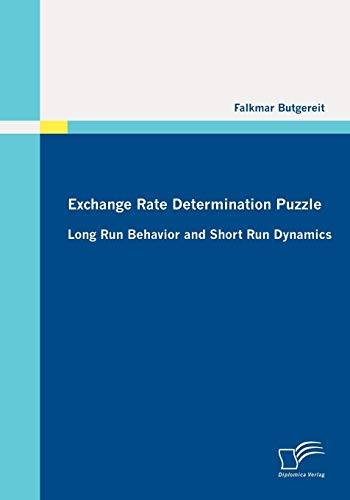
2010, ISBN: 9783836695435
Still after more than thirty years of free floating exchange rates, large parts of exchange rate dynamics remain a puzzle. As this book shows, much progress has been made in explaining ex… Mehr…
| Weltbild.de Nr. 24679879. Versandkosten:, 2-5 Werktage, DE. (EUR 0.00) Details... |

2010, ISBN: 9783836695435
Still after more than thirty years of free floating exchange rates, large parts of exchange rate dynamics remain a puzzle. As this book shows, much progress has been made in explaining ex… Mehr…
| Weltbild.de Nr. 24679879. Versandkosten:, 2-5 Werktage, DE. (EUR 0.00) Details... |

2010, ISBN: 9783836695435
Diplomica Verlag, Paperback, 120 Seiten, Publiziert: 2010-07-30T00:00:01Z, Produktgruppe: Book, Hersteller-Nr.: black & white illustrations, 0.22 kg, Books Global Store, Special Features,… Mehr…
| amazon.co.uk Versandkosten:Die angegebenen Versandkosten können von den tatsächlichen Kosten abweichen. (EUR 5.60) Details... |

2010, ISBN: 383669543X
[EAN: 9783836695435], Neubuch, [PU: Diplomica], New Book. Delivered from our UK warehouse in 4 to 14 business days. THIS BOOK IS PRINTED ON DEMAND. Established seller since 2000, Books
| AbeBooks.de PBShop.store UK, Fairford, GLOS, United Kingdom [190245] [Rating: 5 (von 5)] NEW BOOK. Versandkosten: EUR 9.35 Details... |

2010, ISBN: 383669543X
[EAN: 9783836695435], Neubuch, [PU: Diplomica Verlag], Books
| AbeBooks.de Lucky's Textbooks, Dallas, TX, U.S.A. [60577173] [Rating: 5 (von 5)] NEW BOOK. Versandkosten: EUR 68.68 Details... |


2010, ISBN: 9783836695435
Still after more than thirty years of free floating exchange rates, large parts of exchange rate dynamics remain a puzzle. As this book shows, much progress has been made in explaining ex… Mehr…

2010, ISBN: 9783836695435
Still after more than thirty years of free floating exchange rates, large parts of exchange rate dynamics remain a puzzle. As this book shows, much progress has been made in explaining ex… Mehr…

2010
ISBN: 9783836695435
Diplomica Verlag, Paperback, 120 Seiten, Publiziert: 2010-07-30T00:00:01Z, Produktgruppe: Book, Hersteller-Nr.: black & white illustrations, 0.22 kg, Books Global Store, Special Features,… Mehr…

2010, ISBN: 383669543X
[EAN: 9783836695435], Neubuch, [PU: Diplomica], New Book. Delivered from our UK warehouse in 4 to 14 business days. THIS BOOK IS PRINTED ON DEMAND. Established seller since 2000, Books

2010, ISBN: 383669543X
[EAN: 9783836695435], Neubuch, [PU: Diplomica Verlag], Books
Bibliographische Daten des bestpassenden Buches
| Autor: | |
| Titel: | |
| ISBN-Nummer: |
Detailangaben zum Buch - Exchange Rate Determination Puzzle: Long Run Behavior and Short Run Dynamics
EAN (ISBN-13): 9783836695435
ISBN (ISBN-10): 383669543X
Gebundene Ausgabe
Taschenbuch
Erscheinungsjahr: 2010
Herausgeber: Diplomica Verlag
120 Seiten
Gewicht: 0,303 kg
Sprache: eng/Englisch
Buch in der Datenbank seit 2009-02-26T14:08:21+01:00 (Vienna)
Detailseite zuletzt geändert am 2024-03-24T02:20:28+01:00 (Vienna)
ISBN/EAN: 9783836695435
ISBN - alternative Schreibweisen:
3-8366-9543-X, 978-3-8366-9543-5
Alternative Schreibweisen und verwandte Suchbegriffe:
Titel des Buches: long may you run, puzzle, dynamics behavior, exchange rate determination
Daten vom Verlag:
Autor/in: Falkmar Butgereit
Titel: Exchange Rate Determination Puzzle: Long Run Behavior and Short Run Dynamics
Verlag: Diplomica Verlag
120 Seiten
Erscheinungsjahr: 2010-07-04
Gewicht: 0,240 kg
Sprache: Englisch
48,00 € (DE)
48,00 € (AT)
Not available (reason unspecified)
BC; PB; Hardcover, Softcover / Wirtschaft/Volkswirtschaft; Wirtschaftswissenschaft; Wirtschaft; UEP; exchange rates; random walk; underlying fundamentals; PPP; speculation; chartism; EA
Weitere, andere Bücher, die diesem Buch sehr ähnlich sein könnten:
Neuestes ähnliches Buch:
9783836645430 Exchange Rate Determination Puzzle: Long Run Behavior and Short Run Dynamics (Falkmar Butgereit)
- 9783836645430 Exchange Rate Determination Puzzle: Long Run Behavior and Short Run Dynamics (Falkmar Butgereit)
- 9783836632188 Exchange Rate Determination Puzzle - Long Run Behavior and Short Run Dynamics (Falkmar Butgereit)
- Exchange Rate Determination Puzzle: Long Run Behavior and Short Run Dynamics (Falkmar Butgereit,,)
< zum Archiv...

